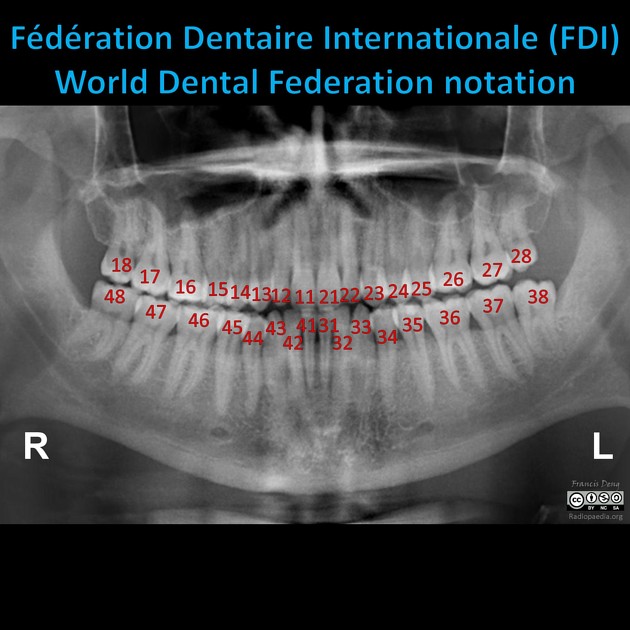The orthopantomogram (also known as an orthopantomograph, pantomogram, OPG or OPT) is a panoramic single image radiograph of the mandible, maxilla and teeth. It is often encountered in dental practice and occasionally in the emergency department; providing a convenient, inexpensive and rapid way to evaluate the gross anatomy of the jaws and related pathology.
On this page:
Indications
There are multiple indications for this type of radiograph including yet not limited to:
general dental health evaluation for caries or pulp origin disease
trauma assessment for tooth or jaw fractures
infection evaluation of sinusitis, periodontitis or periapical abscesses
tumor or radicular cyst evaluation
temporomandibular joint assessment for disease, fractures or dislocations
facial bone disease evaluation
foreign body localization
salivary stone identification (sialolithiasis)
growth and development monitoring of pediatric teeth for location, shape, angle, supernumerary tooth presence and tooth germ absence to prevent or prepare for future aesthetic issues
initial and progressive evaluation of orthodontic treatment (note an OPG alone is not usually sufficient for preoperative inspection or prosthesis measurement)
Patient position
During an OPG the patient remains in a stationary position (seated or standing) while both the x-ray source and film rotate in combination around the patient. The x-ray source rotates from one side of the jaw, around the front of the patient, and then to the other side of the jaw. The film rotates opposite to the x-ray source behind the patient. It takes a few seconds during which the patient must remain completely still.
Technical factors
panoramic projection
paused respiration (departmentally dependant)
-
centering point
Frankfort's horizontal line is parallel to the floor
-
laser lights will be vendor-specific however
central laser light in the midsagittal plane
axial laser light at the IOML
lateral laser light at the lateral incisor
-
orientation
landscape
-
detector size
OPG specific detector
-
exposure
70-80 kVp
8-15 mA over a number of seconds
-
grid
yes
Image technical evaluation
-
radiolucency over maxillary teeth
tongue not against the hard palate
-
hard palate superimposed on roots, flat occlusal plane, condyles at the edge
chin too high
-
mandible is V-shaped, too much smile line
chin too low
-
unequal condyles, slanted mandible, distorted nasal structures
head tilted to side
-
teeth wide on one side and narrow on the other, condyle size asymmetry
head turned to side
-
anterior teeth blurry small and narrow, large amount of spine visible on edges
too far forwards
-
anterior teeth blurry and wide, ghosting of mandible and spine, condyles close to the edge
too far backwards
-
blurred image
movement
-
artifact
Practical points
All jewelry, dentures, hearing aids and glasses should be removed. The patient should be positioned:
sitting/standing completely upright
head immobilized and on a chin rest
biting down on a radiolucent bite block
tongue against the hard palate
Correct positioning is empirical for a sharp, accurate and undistorted image. OPG positioning errors are common affecting 60-96% of radiographs; rendering 5-33% uninterpretable. The most common error is tongue not against the hard palate. For interpretation purposes, it is important to be aware of common errors and how they affect image quality.
Technique
This technique creates a panoramic image that should include the lower limits of the mandible, the upper limits of the maxillary sinuses, and the mandibular condyles and temporomandibular joints laterally. Panoramic image limitations include inherent anatomy distortion, double images, ghost images and that they do not provide an accurate spatial relationship between structures.








 Unable to process the form. Check for errors and try again.
Unable to process the form. Check for errors and try again.